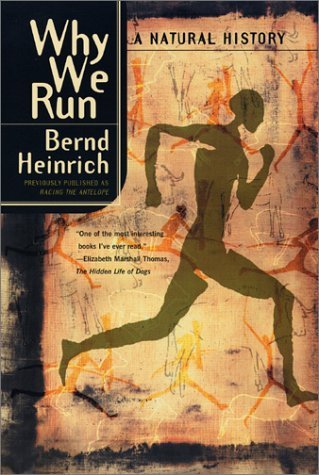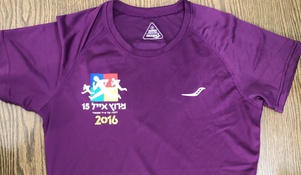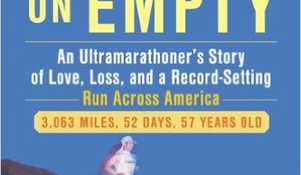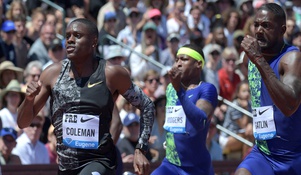Book Review: Why We Run, by Bernd Heinrich

In Why We Run: A Natural History, originally published in 2001 as Racing the Antelope: What Animals Can Teach Us About Running and Life, author Bernd Heinrich recounts his growth as a runner and scientist from childhood through high school and college and into adulthood, culminating in his competition in the North American 100-kilometer championships in Chicago in 1981 at age 41. The various stations in Heinrich's life make for interesting reading, particularly those that relate directly to his experience as a runner, and his recollections are communicated with a prose that is fluid and engaging.
Running and biology being Heinrich's lifelong passions, he tries to weave the two together into a single narrative. It is a novel approach as far as books on running go, and for the most part it is effective. However, it is not without its flaws. The narrative gets bogged down at times with tedious descriptions of such things as insect anatomy and mating rituals. Heinrich tries to demonstrate the relevance of his research to the world of running and to his own racing strategies; but in broadening his scope to include seemingly every organism that he ever studied, he packs in too much information where being selective would have been preferable.
Unless the "We" in Why We Run is referring to animals generally, the revised title turns out to be a poor choice of words when compared with the original. Heinrich explains why he renamed the book, but the fact of the matter is is that the vast majority of humans do not run. The instinct for distance running, even if it corresponds to an evolutionary advantage we still possess, no longer plays a role in our lives. Humans do not depend on running for survival, nor is it an activity we engage in for pleasure. It is true there are those for whom running is a passion, and those are precisely the ones Heinrich had in mind in the original title, those who live to chase and to beat the proverbial antelope -- but they are very much the exception to the rule. Potentially, a no less interesting book could be written with the title, Why We Stopped Running.
The antelope theme also happens to be central to Heinrich's running philosophy, on both the literal and the figurative level. The pronghorn antelope is a paragon of endurance, built for distance -- "the ultimate mammalian endurance athlete." It may not offer practical insights into running mechanics or energy management, but it is a wonder of nature, to be marveled over and appreciated. At the same time, it is a symbol of willpower, and as such its spirit is something to be internalized, absorbed into one's own identity and channeled to becoming a more determined runner. "There are no tricks. No one adaptation by itself makes the difference. Pronghorns are just better at everything that affects sustained running speed. That is as expected. There is no use in having any one link in the system with extra capacity relative to any other -- there is no point, for example, to have an oxygen delivery system to the muscles that greatly exceeds the capacity of those muscles to utilize the oxygen. Aside from that, the antelope is more than the sum of its parts, and no dissection will ever isolate the greatest of all antelope attributes, the antelope's spirit and enthusiasm for running." There is only so much we can do to enhance our physiology, but our mind is another matter.
In one of the most intriguing parts of the book, which regrettably is also the briefest, Heinrich recalls the experiments he carried out with various fuel sources while training for the 100-kilometer championship. These included honey, beer and olive oil. Were the havoc-wreaking effects of alcohol on the body's hydration mechanisms not widely known in the 80s? In the movie Run for Your Life, on Fred Lebow and the the history of the NYC Marathon, it is recalled that runners used to be offered shots of whiskey (or was it vodka?) at aid stations -- so perhaps Heinrich was indeed exploring uncharted territory. Either way, as it would be unheard of today to fuel a run with beer or olive oil, a more detailed portrayal of his experiments would have constituted a unique contribution to the world of running folklore.
We all went through that science class where we had to dissect a frog. There's always the girl that throws up and the student who brings in a form signed by his parents exempting him from participation. I don't remember experiencing any nausea or moral compunctions when I put scalpel to pale blue-green flesh back in 8th grade, and I probably wouldn't experience any today. But I would absolutely feel differently if, say, a cat or an owl were on the operating tray. Needless to say, experiments on living animals I would find thoroughly intolerable. Yet Why We Run is replete with descriptions of experiments performed on living creatures. One of the most unsettling of these involved running an antelope on a treadmill with a breathing mask to exhaustion in order to measure its V02max. In the 21st century, a pause on the author's part to consider the ethical implications of such methods should be standard procedure. I would have felt more comfortable were there an assurance such as is common in the cinematic world along the lines of, No animals were harmed in the making of this book. Alas, my feeling is that the opposite is the case -- many animals were harmed.
Why We Run opens strong: the reader develops an emotional attachment to the narrator early on. Later, Heinrich's experiences in high school and college are engrossing as his emergence as an elite runner unfolds. Once the narrative advances to his professional career as a biologist, the pace slows. Here there were times I continued reading just to get to the next page. Close to the end of the book, Heinrich has finally built up his story to its climax -- the 100K race. Races are inherently exciting in their competitiveness, unpredictability, and test of will. In contrast to the preceding chapters, here I found myself pulling out my phone to read another paragraph or two with every opportunity I had.
The book is deserving of 3 stars out of five: on the whole a decent story, but it's not one I feel I'll ever need to reread, it's not one I would recommend, and it's certainly not one I would consider brilliant.





